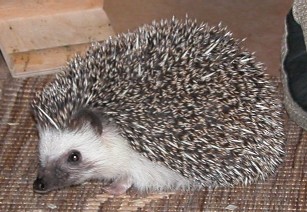|
| Query: Common toad | Result: 123rd of 127 | |
African Pygmy Hedgehog, Four-toed Hedgehog (Atelerix albiventris) - Wiki
| Subject: | African Pygmy Hedgehog, Four-toed Hedgehog (Atelerix albiventris) - Wiki
| |

| Resolution: 307x212
File Size: 31641 Bytes
Upload Date: 2007:10:29 11:24:06
|
Four-toed Hedgehog
From Wikipedia, the free encyclopedia
[Photo] Fully grown African Four-toed Hedgehog called "Tepsu". Photo by http://fi.wikipedia.org/wiki/K%C3%A4ytt%C3%A4j%C3%A4:Jkasvi | Permission is granted to copy, distribute and/or modify this document under the terms of the GNU Free Documentation License, Version 1.2 or any later version published by the Free Software Foundation; with no Invariant Sections, no Front-Cover Texts, and no Back-Cover Texts. A copy of the license is included in the section entitled "GNU Free Documentation License". |
The Four-toed Hedgehog (Atelerix albiventris), or African Pygmy Hedgehog, is a small species of hedgehog found throughout much of the south-Saharan African countries, from Senegal and Mauritania in the west, to Sudan in the east, and it has been recorded as far south as Zambia. Populations tend to be scattered between suitable savannah or cropland habitats, avoiding forested areas. The species common name is derived from the number of toes found on it rear feet. Due to its extensive range and stable wild population, the species holds no particular conservation status.
Physical description
The Four-toed Hedgehog is an oval bodied animal between 15 and 25cm in length and weigh between 350 and 700 grams. Females are typically larger than males. It has short legs, a long nose, and small beady eyes. It can vary greatly in coloration, but typical wild specimens have brown or grey spines with white or cream colored tips. It has soft fur on its underbelly and its face. Its face usually exhibits a darker coloration, grey or black, or is the same color as its underside, which is typically white.
Behaviour
The Four-toed Hedgehog is a solitary, nocturnal animal. It is highly energetic, sometimes covering miles of ground in a single night as it forages for insects, grubs, snails, spiders, some plant matter, and even small vertebrates. It has a high tolerance for toxins and has been recorded consuming scorpions and even venomous snakes. When encountering a predator, its standard defensive reaction is to tense up all the muscles on its back to cause its spines to stand erect, and then roll into a ball protecting its limbs and head. If it is harassed further, it will twitch in an attempt to jab spines into the predator and make snuffling/grunting noises. Its spines are not released into the skin of an attacker, as those of a porcupine. In fact, hedgehogs don't lose quills during adulthood except for very rarely; heavy quill loss is usually a warning sign as to the animal's health.
When the Four-toed Hedgehog is introduced to a new or particularly strong smell, it will sometimes do what is referred to as self-anointing. It creates a frothy saliva and spreads it onto its quills in incredible amounts. It is not really understood why it does this, but it is thought to be a defensive action, as hedgehogs have been known to self-anoint with poisonous toads.
This species tends to prefer temperatures between 24 and 30 °C. When it is hotter than that, it tends to find shelter in a burrow and go into a state of estivation, or when it is colder it goes into a state of hibernation in order to conserve energy.
Reproduction
Female Four-toed Hedgehogs do not go into estrus at any particular time of year, they will ovulate when the conditions are right and there is a male present ??? which is typically during the rainy season when food is abundant. Males approach the female and court her with high pitched vocalizations. Gestation lasts approximately 35 days. The young are born covered in a thin membrane to protect the mother from their already present spines, though it takes them some time to gain control over the muscles that move them. Litter size is usually around 3 or 4, but they are capable of having upwards of 8 at a time. The babies are weaned by 6 weeks and leave the mother not long after, becoming sexually mature at 2-3 months of age. Females generally have 1-2 litters per year.
In captivity
The Four-toed Hedgehog is one of the most popular species of domesticated hedgehog sold in the exotic pet trade. It is bred extensively for color and temperament and is even displayed in competitive hedgehog shows. Lifespan is typically 4-6 years. Due to its energetic nature, many owners provide their hedgehog with a large running wheel. Some measure the distances their pets run every night, and some have claimed that their hedgehogs run upwards of 8 km a night with speed bursts in excess of 16 km/h. When kept in captivity, at more regulated temperatures, this species does not typically display its estivation or hibernation behaviour. Due to the large amount of breeding stock available in captive collections, the Four-toed Hedgehog is rarely imported from the wild any longer. Several US and Canadian localities ban ownership of this species, or require special permits for them. Hedgehogs are generally hardy animals when kept properly, though they may be vulnerable to the growth of tumors as they mature.
http://en.wikipedia.org/wiki/Four-toed_Hedgehog
| The text in this page is based on the copyrighted Wikipedia article shown in above URL. It is used under the GNU Free Documentation License. You may redistribute it, verbatim or modified, providing that you comply with the terms of the GFDL. |
|
^o^
Animal Pictures Archive for smart phones
^o^
|
|